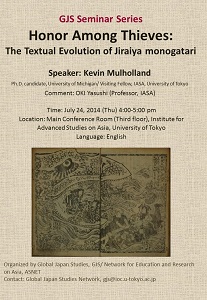以下の通り、第99回目の東文研・ASNET共催セミナー/第2回GJSセミナーを開催しました。
【日時 / Date】
2014年7月24日(木)16:00-17:00
July 24, 2014 (Thu) 4:00-5:00 pm
【会場 / Venue】
東京大学 東洋文化研究所 3階 大会議室
Main Conference room 303 (3rd floor), Institute for Advanced Studies on Asia, The University of Tokyo
【報告者】
ケヴィン・ムルホランド氏 (東洋文化研究所・訪問研究員)
Kevin Mulholland (Visiting Fellow, IASA)
【題名 / Title】
盗賊たちの栄誉―『自来也説話』におけるテクストの革命
Honor Among Thieves: The Textual Evolution of Jiraiya monogatari
【コメント / Comment】
大木康氏(東洋文化研究所・所長)
OKI Yasushi (Professor, IASA)
【要旨 / Abstract】
今日では「自来也(児雷也)」は忍術や蝦蟇と無関係に考えられないが、本書が日本文学において最初に著された際には勇敢な
盗賊(義賊)が奇妙なほど栄誉を持って語られた。本発表では、『自来也物語』もしくは『自来也説話』に見られるテクストの展開
を追究することによって、文学研究の基礎的な関心であるテクストの本質について検討したい。
山東京伝の『忠臣水滸伝』や曲亭馬琴の『南総里見八犬伝』の影に追いやられながらも、感和亭鬼武の『報讎自来也物語』(1806年)
ならびに『自来也物語後編』(1807年)は転換期にある近代初期の日本の物語の分野において重要な位置を占めている。これら
二編の成功は、近松徳三の『柵自来也談』(1807年)や『歌舞伎精巧戯棚之修飾自来也物語』(1809年)のような劇作版を生み出した。
これらの演劇の上演は、人気の絶頂となった合巻の『児雷也豪傑譚』(1839-1868年)など「自来也」に新たな息吹をもたらすことと
なった。およそ三十年におよび『児雷也豪傑譚』は感和亭の原作という原型を意識してはいたが、主人公である「自来也」の本性は
合巻というメディアの流行や連載への要求に合わせて変化していると言える。
これらの「自来也物語」がさまざまな形で表現化されていったことに鑑みて、口承文学などの語り物や小説という形式のうえでの
関係性、物語の構成において江戸や大坂の間で出版交流の果たした役割、版本と演劇との相互関係、主人公の本性を再構築すること
となった言葉と視覚の両者に訴える浮世絵の影響など、近代初期の日本文学が19世紀を通じていかなる改変を遂げてきたのかなど、
さまざまな視点を明らかにしてみたい。
Now Jiraiya is inseparably associated with ninjutsu and frogs, but his first appearance in Japanese literature is that
of a valiant thief(/gizoku/) with questionable honor. This talk addresses the fundamental concern of literary studies,
the nature of the text, by tracing the textual evolution of /Jiraiya monogatari/, or /The Tale of Jiraiya/.
Overshadowed by Santô Kyôden’s /Chûshin suikoden/ and Kyokutei Bakin’s/Nansô Satomi hakkenden/, both Kanwatei Onitake’s
/Katakiuchi Jiraiya monogatari /(1806) and his /Jiraiya monogatari kôhen/ (1807) occupy an important position within a
field of early modern Japanese narratives at a moment of transition. The success of these two books quickly inspires
the publication of two stage adaptations, Chikamatsu Tokusô’s /Yaemusubi Jiraiya monogatari/ (1807) and /Kabuki seikô
gekidana no shûshoku Jiraiya monogatari /(1809). The staging of these plays gives Jiraiya a life of his own, which
culminates in the immensely popular /gôkan//Jiraiya gôketsu monogatari/ (1839-1868). Spanning nearly three decades,
/Jiraiya gôketsu/ /monogatari /begins conscious of the archetypes set in Kanwatei’s original work, but the nature of
the Jiraiya character changes to suit the trends of the /gôkan /medium and the need for serialization.
An exploration of these different instantiations of the /Jiraiya monogatari/ narrative reveals several aspects of how
early modern Japanese narratives changed over the 19th century, including, the relationship of oral storytelling to
the novel form, the role of the book trade between Edo and Osaka in the formation of narratives, the interactions between
print and stage, and the impact visual-verbal print has in redefining the nature of a character.
【使用言語 / Language】
英語 / English




